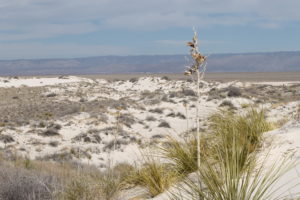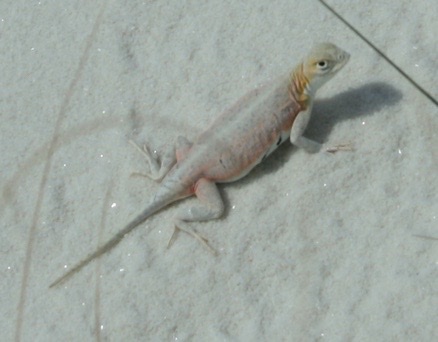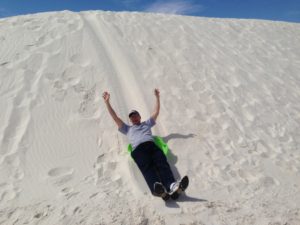My atlas shows a long narrow rectangle in purple, extending from the southern border of central New Mexico to the north for about 150 miles. The purple rectangle is the White Sands Missile Range, and buried inside it is the White Sands National Monument, a place of natural beauty like none other in the world.

White Sands National Monument was established by President Herbert Hoover on January 18, 1933. Hoover did so to protect “the white sands and additional features of scenic, scientific, and educational interest.” He got that right. The 142,987-acre national monument features a portion of the world’s largest gypsum crystal “sand dune.” The white sand dune (not sand, but gypsum crystals—the stuff that dry-wall is made of) is 275 square miles in extent; the next largest is 3 square miles! About half of the dune itself is in the national monument, the rest is in the missile range.
The region has seen waves of habitation for at least 10,000 years. Nomadic peoples hunted the area when it was covered in grasslands. When the post-ice-age climate changed, the land dried up, as did human use. About 1800 years ago, Native American farmers came to the area, only to disappear as had previous inhabitants. Starting about 700 years ago, Native American Apache groups colonized the arid, unforgiving environment; their descendants remain.
But it is hard to scrape a living from the dry, wind-blown landscape. Repeated attempts to farm, ranch or mine by Spanish colonists and American pioneers have failed to stake a permanent claim at white sands. The U.S. government has found a use, however—as a distant, isolated, barely inhabited place to develop and test long-range weapons. The northern end of the White Sands Missile Range holds the “Trinity Site,” where the first atomic bomb was detonated in tests on July 16, 1945. The Army tests rockets there to this day, with many successful spacecraft having flown first above these white dunes.
Thanks to President Hoover, a significant portion of the white gypsum dunes are protected as a unique ecosystem and a recreational haven. More than 800 animal species reside there, most of them nocturnal. Sometimes called the “Desert Galapagos,” White Sands is home to a variety of white reptiles and insects that have adapted—and are adapting—to the hot, bright days and cold nights of the region. One unique species is the White Sands pupfish, that survives in four isolated populations in spring-fed ponds and streams.

Most recreation at White Sands is for day use only, as the environment is unrelentingly harsh. Facilities in the park were built by the Civilian Conservation Corps in the 1930s, graceful stone picnic shelters that remind us of the great legacy of conservation that grew from the Great Depression (learn more about the CCC here). A favorite outdoor activity is sand-dune sledding, with inexpensive saucer sleds for sale in the park gift shop—it is great fun (I’ve done it!). From an initial annual visitation of 12,000 in 1933, now more than half a million visitors enjoy the park every year.
And, on December 20, 2019, President Donald Trump signed legislation that redesignated White Sands as a National Park.

References:
Block, Melissa, and Elissa Nadworny. 2017. Photos: The cream, Sculpted dunes Of White Sands National Monument. NPR special series: Our Land. April 9, 2017. Available at: https://www.npr.org/2017/04/09/520874659/photos-the-creamy-sculpted-dunes-of-white-sands-national-monument. Accessed January 17, 2018.
Conrod, William and Erica Bree Rosenblum. 2008. A Desert Galapagos. Natural History Magazine, May 2008, pages 16-18. Available at: https://www.nps.gov/whsa/learn/nature/upload/Desert_Galapagos_-287KB_PDF.pdf. Accessed January 17, 2018.
National Park Service. White Sands National Monument. Available at: https://www.nps.gov/whsa/index.htm. Accessed January 17, 2018
